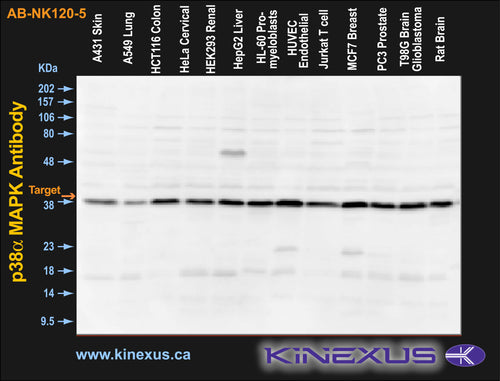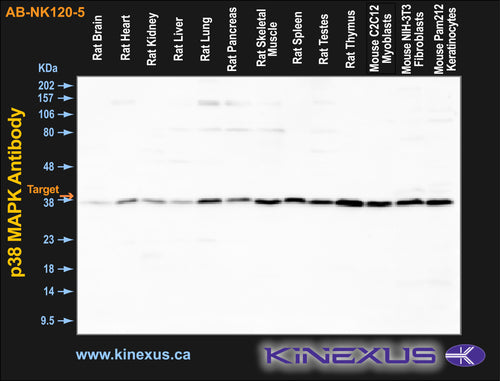Product Name:
p38a-2
Product Number:
ab-nk120-5
Target Full Name: Mitogen-activated protein-serine kinase p38 alpha; Mitogen-activated protein kinase 14
Target Alias: CRK1; CSAID binding protein; CSBP; CSBP1; CSBP2; CSPB1; Cytokine suppressive anti-inflammatory drug binding protein; Kinase p38-alpha; MAPK14; PRKM15; p38a MAPK; SAPK2A; Mxi2; CCDS4815.1; ENSG00000112062
Product Type Specific: Protein kinase pan-specific antibody
Antibody Code: NK120-8
Antibody Target Type: Pan-specific
Protein UniProt: Q16539
Protein SigNET: Q16539
Antibody Type: Polyclonal
Antibody Host Species: Rabbit
Antibody Immunogen Source: Human p38a MAPK (MAPK14) sequence peptide Cat. No.: PE-01AYB90
Antibody Immunogen Sequence: CDQSFESRDLLIDEWK
Antibody Immunogen Description: Corresponds to amino acid residues D324 to K338; Post-kinase last alpha-chain
Production Method: Corresponds to amino acid residues D324 to K338; Post-kinase last alpha-chain
Antibody Modification: Protein kinase pan-specific antibody
Antibody Concentration: 1 mg/ml
Storage Buffer: Phosphate buffered saline pH 7.4, 0.05% Thimerasol
Storage Conditions: For long term storage, keep frozen at -40°C or lower. Stock solution can be kept at +4°C for more than 3 months. Avoid repeated freeze-thaw cycles.
Product Use: Western blotting | Antibody microarray
Antibody Dilution Recommended: 2 µg/ml for immunoblotting
Antibody Species Reactivity: Human
Antibody Positive Control: The observed molecular mass of the processed target protein on SDS-PAGE gels is reported to be around 38-43 kDa.
Antibody Specificity: Very high
Antibody Cross Reactivity: Very weak immunoreactivity on protein dot blots with p38b, and no immunoreactivity with recombinant human p38d and p38g.
Related Product 1: p38a-2 blocking peptide
Related Product 2: p38 pan-specific antibody (Cat. No.: AB-NK120-5)
Related Product 3: p38 alpha (MAP Kinase) pan-specific antibody (Cat. No.: AB-NK120-4)
Related Product 4: p38a-pT180+pY182 phosphosite-specific antibody (Cat. No.: AB-PK739)
Related Product 5: p38a-pT180+Y182 phosphosite-specific antibody (Cat. No.: AB-PK740)
Related Product 6: p38SelectideA - p38a MAPK (MAPK14) protein kinase substrate peptide
Related Product 7: p38Subtide - p38a MAPK (MAPK14) protein kinase substrate peptide
Related Product 8: p38 MAPK KinSub - p38 MAPK peptide substrate
Scientific Background: p38a (MAPK14) is a protein-serine/threonine kinase of the CMGC group and MAPK family, and a member of the p38 stress-activated MAP kinases. It is activated by pro-inflammatory cytokines, environmental stress and LPS. Phosphorylation at T180 and Y182 increases its phosphotransferase activity. These phospho-sites are targeted by MKK3 (MAP2K3), MKK6 (MAP2K6), and potentially also MKK4 (MAP2K4). Phosphorylation at Y323 also increases its phosphotransferase activity. It is inhibited by dual specificity phosphatases, such as DUSP1. Phosphorylation at T123 inhibits phosphotransferase activity and interaction with MKK6 and MAPKAPK2. Its many substrates include the transcription regulators ATF2, MEF2C, and MAX; the cell cycle regulator CDC25B; and p53, which indicates that p38a plays a role in stress-related transcription and in cell cycle regulation, as well as in the genotoxic stress response. It is a key player in the maintenance of hematopoiesis homeostasis, as it balances both proliferative and growth inhibitory signals from growth factors/cytokines that regulate hematopoiesis. Alterations in this controlled balance could result in either overproduction or depletion of myelosuppressive cytokines, which could lead to the development of various types of bone marrow failures. p38a may be also involved in drug resistance development of acute myeloid leukemias.



